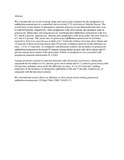| dc.description.abstract | Abstract
We evaluated the use of silver nitrate drops and tetracycline ointment for the prophylaxis of ophthalmia neonatorum in a controlled trial involving 2732 newborns in Nairobi, Kenya. The overall rates of prevalence of intrapartum maternal gonococcal and chlamydial infection were 6.4 and 8.9 percent, respectively. After prophylaxis with silver nitrate, the incidence rates of gonococcal, chlamydial, and nongonococcal, nonchlamydial ophthalmia neonatorum were 0.4, 0.7, and 6.2 percent, respectively, whereas after prophylaxis with tetracycline, the rates were 0.1, 0.5, and 4.5 percent. The attack rates of gonococcal ophthalmia neonatorum in newborns exposed to Neisseria gonorrhoeae at birth were 7.0 percent in those receiving silver nitrate and 3.0 percent in those receiving tetracycline (95 percent confidence interval for the difference in rates, -3.4 to 11.4 percent). As compared with historical controls, the incidence of gonococcal ophthalmia neonatorum decreased 83 percent among infants treated with silver nitrate and 93 percent among those treated with tetracycline. Failure of prophylaxis was associated with postpartum maternal endometritis (P = 0.05).
Among newborns exposed to maternal infection with Chlamydia trachomatis, chlamydial conjunctivitis developed in 10.1 percent given silver nitrate and in 7.2 percent given tetracycline (95 percent confidence interval for the difference in rates, -4.7 to 10.5 percent), yielding reductions in the incidence of chlamydial ophthalmia of 68 and 77 percent, respectively, as compared with the historical controls.
We conclude that tetracycline is as effective as silver nitrate in preventing gonococcal ophthalmia neonatorum. (N Engl J Med 1988; 318:653–7.) | en_US |

